- Last Updated: December 16th, 2025
Key Takeaways
Skin conditions like acne and rashes are common signs of PCB exposure after contact with contaminated materials.
Pay attention to digestive issues such as nausea or intolerance to fatty foods that may hint at consuming PCB-laden food or dairy products.
Neurological symptoms, including fatigue and headaches, stemming from chronic exposure are commonly seen in environments with old electrical equipment containing PCBs.
Overview of PCB Exposure Symptoms
On this page, we’ll discuss how to identify the signs and symptoms of PCB exposure, recent scientific studies conducted on PCB contamination, who qualifies to file a PCB exposure lawsuit, and much more.
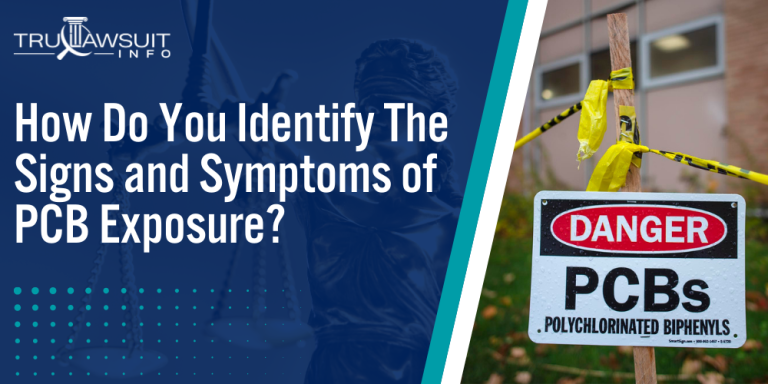
Intro to PCB Exposure Symptoms
Health problems related to PCB exposure can vary depending on the amount and duration of exposure.
The key signs and symptoms of PCB exposure include the following:
- Skin conditions such as acne and rashes
- Changes in blood and urine indicating potential liver damage
- Neurological symptoms
- Respiratory issues
- Eye irritation, nausea, and vomiting
If you or a loved one has experienced adverse health conditions after being exposed to PCB chemicals, you may be eligible to pursue compensation.
Contact TruLawsuit Info today using the chat on this page to receive an instant case evaluation.
Common Routes of PCB Exposure
Polychlorinated biphenyls (PCBs) are synthetic chemicals found in many industries and environments.
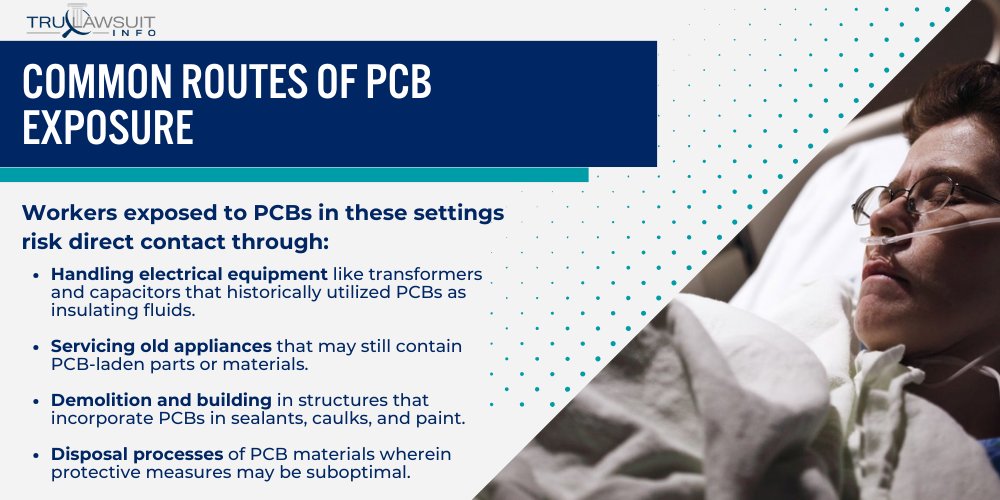
The following subsections detail specific pathways through which individuals may come into contact with PCBs.
Occupational Exposure
Individuals working in industries that manufacture or use PCB-containing equipment may face occupational exposure.
Workers exposed to PCBs in these settings risk direct contact through:
- Handling electrical equipment like transformers and capacitors that historically utilized PCBs as insulating fluids.
- Servicing old appliances that may still contain PCB-laden parts or materials.
- Demolition and building in structures that incorporate PCBs in sealants, caulks, and paint.
- Disposal processes of PCB materials wherein protective measures may be suboptimal.
Environmental Exposure
Environmental exposure to PCBs can occur indiscriminately, affecting those who are not directly working with PCB materials.
Various scenarios of environmental exposure include:
- Breathing contaminated air that might emanate from hazardous waste sites or improperly disposed PCB materials.
- Contact with contaminated soil or water, especially in or around areas where PCBs were improperly disposed of.
- Living in buildings with PCB-containing materials, such as certain paints or sealants.
- Swimming or bathing in contaminated waterways where PCBs have accumulated.
Dietary Intake
The ingestion of foods tainted with PCBs is a critical pathway through which these harmful substances enter the human body, underscoring the need for vigilance regarding food sources and consumption habits.
Communities located near industrial contamination sites and individuals who frequently consume fish from polluted waters are particularly at risk.
Dietary intake of PCBs remains a potential concern through:
- Eating contaminated food, particularly from sources near industrially polluted areas.
- Consuming PCB-contaminated fish is a significant risk as PCBs bioaccumulate in aquatic ecosystems.
- Eating contaminated fish, as fish, can absorb PCBs from sediments and surrounding water, concentrating them up the food chain.
- Traces of PCBs are present in breast milk, posing a risk to nursing infants when the mother has been exposed to PCBs.
Adverse Health Effects Reported: PCB Exposure
Exposure to polychlorinated biphenyls (PCBs) has been associated with a variety of adverse health effects, with symptoms ranging from acute to chronic conditions.
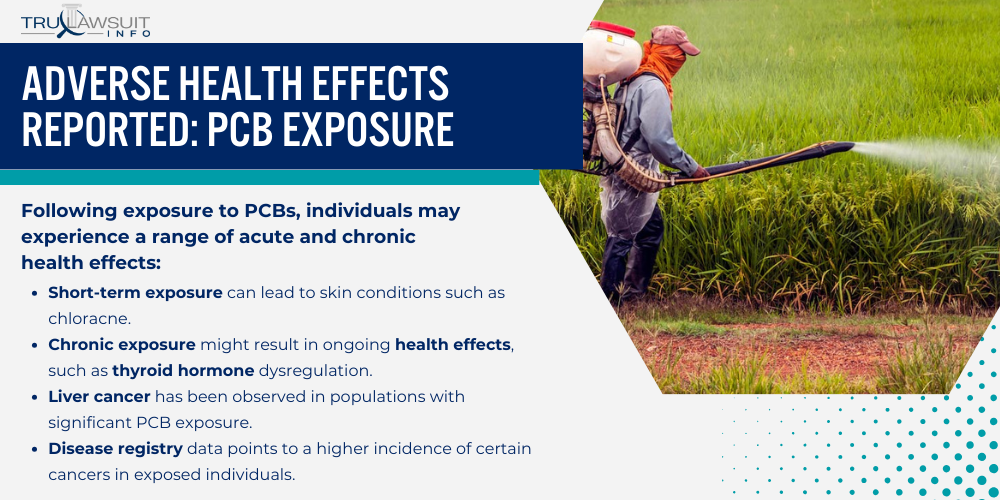
Acute and Chronic Effects
Acute and chronic effects of PCB exposure can manifest differently over time.
Elevated liver enzymes and liver damage are notable examples, indicating a strain on the body’s filtration systems.
Following exposure to PCBs, individuals may experience a range of acute and chronic health effects:
- Short-term exposure can lead to skin conditions such as chloracne.
- Chronic exposure might result in ongoing health effects, such as thyroid hormone dysregulation.
- Liver cancer has been observed in populations with significant PCB exposure.
- Disease registry data points to a higher incidence of certain cancers in exposed individuals.
Reproductive and Developmental Effects
PCBs have been recognized as reproductive and developmental effects disruptors, impacting both adults and developing fetuses.
Exploring the spectrum of PCBs’ effects on reproduction and development reveals a range of concerning health outcomes, such as:
- Reproductive effects may include reduced fertility and alterations in sex hormones.
- Developmental effects can lead to learning disabilities and behavioral issues in children.
- Breast cancer, potentially linked to PCBs, remains a concern as these chemicals can mimic or disrupt normal hormonal functions.
- A disease registry may note the increased occurrence of developmental disorders in areas with high PCB pollution.
Neurological and Immune System Impact
The neurological and immune system impacts from PCB exposure are significant, with neurological symptoms and immune system weaknesses reported.
Further examination of PCB exposure underscores its alarming implications:
- PCBs are viewed as a probable human carcinogen, which can lead to a range of neurological symptoms.
- Serum PCB levels are indicative of overall body burden and can correlate with neurological symptoms.
- PCBs may contribute to an increased risk of breast cancer and other cancers through immune system suppression.
- Long-term exposure is associated with a higher prevalence of auto-immune diseases.
Populations at Greater Risk of PCB Exposure
Certain groups are more likely to encounter PCB exposure due to factors such as occupation, location, and dietary habits.
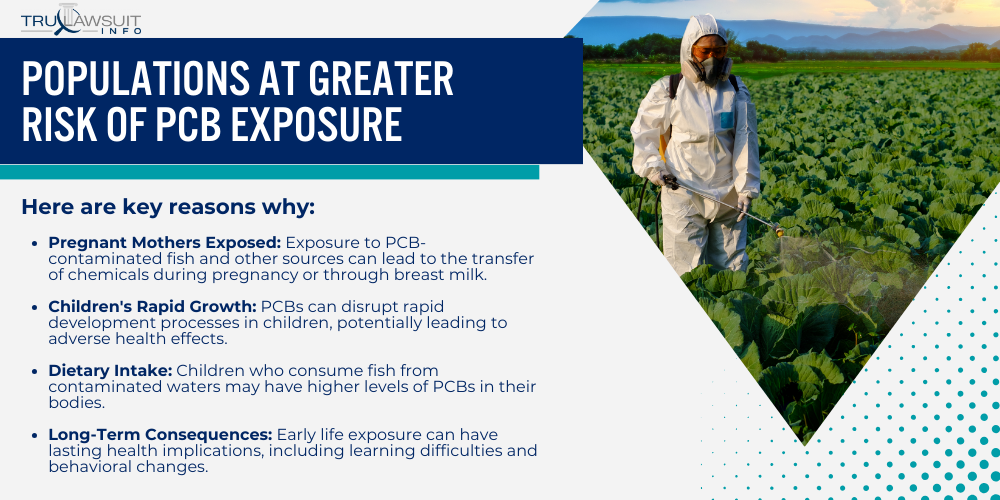
Understanding which populations are at increased risk can aid in targeting public health initiatives and preventative measures.
Children and Pregnant Women
Children and pregnant women are of particular concern when discussing PCB exposure.
The developing systems of fetuses and children are especially sensitive to the toxic effects of PCBs.
Here are key reasons why:
- Pregnant Mothers Exposed: Exposure to PCB-contaminated fish and other sources can lead to the transfer of chemicals during pregnancy or through breast milk.
- Children’s Rapid Growth: PCBs can disrupt rapid development processes in children, potentially leading to adverse health effects.
- Dietary Intake: Children who consume fish from contaminated waters may have higher levels of PCBs in their bodies.
- Long-Term Consequences: Early life exposure can have lasting health implications, including learning difficulties and behavioral changes.
Fishermen and Local Residents
Fishermen working in or near contaminated waters, along with the populations living in close proximity to these areas, often face increased PCB exposure.
They are more directly affected due to both occupational and environmental factors:
- Direct Contact: Handling contaminated fish or spending time in PCB-polluted environments can result in higher exposure levels.
- Dietary Habits: Regular consumption of PCB-contaminated fish significantly contributes to body burden in these populations.
- Increased Risk: Continuous exposure over time might increase the risk of developing PCB-related health conditions.
- Public Health Concerns: Awareness and intervention strategies become critical for protecting the health and well-being of these communities.
Detecting and Measuring PCB Exposure
Identifying PCB exposure is critical due to these compounds’ possible health risks.
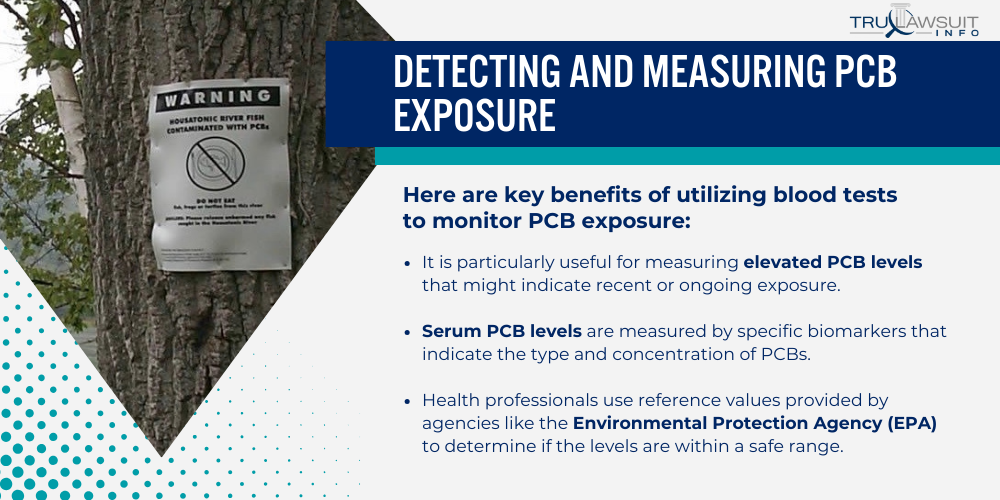
Two primary strategies include biomonitoring using blood tests to measure serum PCB levels and conducting environmental sampling in areas potentially contaminated with PCBs.
Biomonitoring and Blood Tests
Biomonitoring assesses the amount of PCB in the human body.
The detection of PCB levels in blood provides concrete evidence of exposure.
Here are key benefits of utilizing blood tests to monitor PCB exposure:
- It is particularly useful for measuring elevated PCB levels that might indicate recent or ongoing exposure.
- Serum PCB levels are measured by specific biomarkers that indicate the type and concentration of PCBs.
- Health professionals use reference values provided by agencies like the Environmental Protection Agency (EPA) to determine if the levels are within a safe range.
For accuracy, meticulous laboratory procedures are required to ensure that even low levels of PCBs are detected.
Such tests are instrumental in screening for potential health risks and developing public health strategies.
Environmental Sampling
Environmental sampling plays a crucial role in identifying and managing areas with PCB contamination.
To effectively identify and address PCB contamination, the following steps are taken during environmental sampling:
- Soil, water, and air samples are collected from potentially affected environments to measure PCB contamination.
- Methods of sampling include taking surface wipes, sediments, and continuous air samples over a period.
- Elevated PCB levels in these samples can signal the need for remediation efforts to protect public health.
- The Environmental Protection Agency (EPA) sets guidelines for acceptable levels of PCBs in the environment.
- Specialized laboratories analyze these samples using advanced equipment to assess the extent of contamination.
- These assessments guide policymakers in issuing advisories and implementing cleanup operations.
Regulations and Public Safety Measures: PCB Contamination
To protect public health and the environment, specific regulations and safety measures have been established in response to PCB contamination.
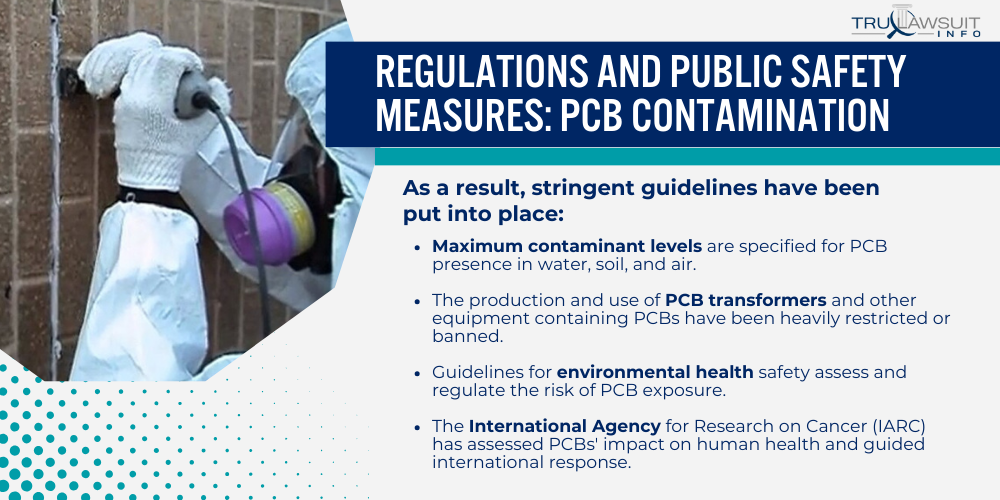
These guidelines and procedures are critical in managing and mitigating PCB-related hazards.
EPA and International Guidelines
The Environmental Protection Agency (EPA) and various international agencies have classified PCBs as probable human carcinogens due to their long-term persistence in the environment and their potential to cause adverse human health effects.
As a result, stringent guidelines have been put into place:
- Maximum contaminant levels are specified for PCB presence in water, soil, and air.
- The production and use of PCB transformers and other equipment containing PCBs have been heavily restricted or banned.
- Guidelines for environmental health safety assess and regulate the risk of PCB exposure.
- The International Agency for Research on Cancer (IARC) has assessed PCBs’ impact on human health and guided international response.
- There is a focus on limiting PCBs in hazardous waste sites through monitoring and regulation.
Cleanup and Control Procedures
When PCB contamination is identified, certain cleanup and control procedures must be enacted to ensure public and environmental safety.
PCB contamination cleanup and control procedures include, but are not limited to:
- Comprehensive site assessment to determine PCB concentration and distribution.
- Removing or replacing equipment containing PCBs, such as PCB transformers, to prevent leaks.
- Decontaminating hazardous waste sites by employing methods like incineration or chemical degradation.
- Ongoing monitoring and testing to ensure that cleanup efforts meet the established safety standards.
- Environmental health agencies recommend dietary and lifestyle advice to populations affected by PCB contamination to minimize additional exposure.
- Implement strict waste disposal controls to prevent future PCB contamination of soil and waterways.
Prevention and Risk Management of PCBs
Identifying and mitigating the risks associated with polychlorinated biphenyls (PCBs) is crucial for preventing negative health outcomes.
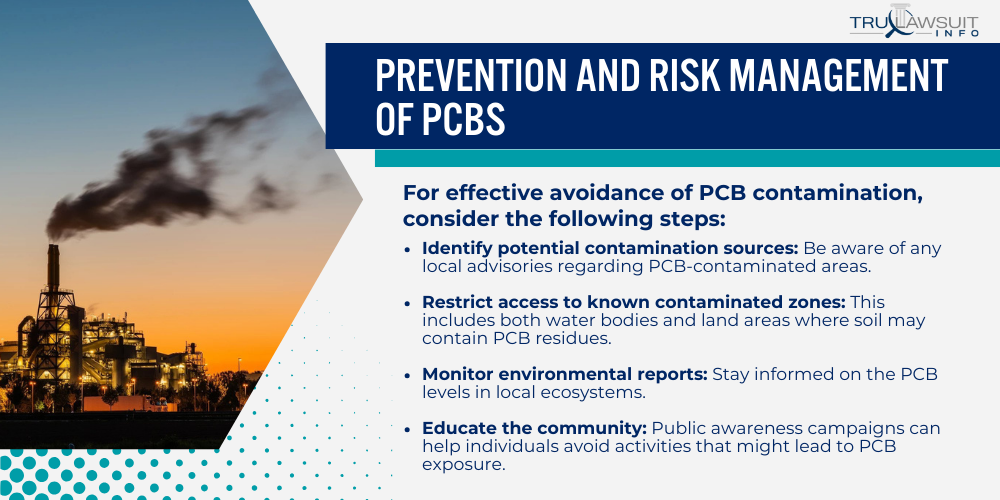
PCBs have been found in contaminated lakes and old fluorescent lighting fixtures, posing risks to both the environment and human health.
Implementing strategies for avoidance and proper handling can significantly reduce exposure.
Avoiding Contaminated Areas
When addressing the risks of PCB exposure, avoiding contaminated areas is paramount.
PCBs can contaminate natural environments, such as lakes and water systems, and can concentrate in fish and other wildlife through the food chain.
For effective avoidance of PCB contamination, consider the following steps:
- Identify potential contamination sources: Be aware of any local advisories regarding PCB-contaminated areas.
- Restrict access to known contaminated zones: This includes both water bodies and land areas where soil may contain PCB residues.
- Monitor environmental reports: Stay informed on the PCB levels in local ecosystems.
- Educate the community: Public awareness campaigns can help individuals avoid activities that might lead to PCB exposure.
Safe Consumption Practices
Safe consumption practices can help minimize the ingestion of PCBs, often found in contaminated water or fish that inhabit such environments.
To ensure the dietary intake of PCBs is minimized, consider the following guidelines:
- Check advisories for fish consumption: Governmental and environmental organizations often issue guidelines on the safety of consuming local fish.
- Limit intake of certain fish: Species known to accumulate higher levels of PCBs should be eaten sparingly, if at all.
- Process fish properly: Clean and cook fish to reduce PCB content, such as skinning and filleting.
- Stay informed about local water safety: Public health departments routinely test water quality to ensure it is safe for drinking and recreational use.
Integrating these strategies into daily practices and community planning can significantly mitigate the risk of PCB exposure, protecting both human health and the environment from the harmful effects of these persistent organic pollutants.
Workplace Safety Protocols
In work environments where PCB exposure is a potential risk, such as facilities with old fluorescent lighting fixtures, stringent workplace safety protocols are essential.
To safeguard employees and minimize the risk of PCB exposure by:
- Regular inspections and maintenance: Ensure any old fixtures are inspected for PCBs and properly maintained or replaced.
- Employee training: Workers should be well-informed about PCB risks and safety measures.
- Personal protective equipment (PPE): Provide appropriate PPE to minimize exposure risks during handling or disposal.
- Routine air and surface testing: Implement testing protocols to detect and address any PCB contamination in the workplace.
By adhering to these safety protocols, businesses can significantly reduce the potential for PCB exposure, ensuring a healthier and safer work environment for all employees.
Impact of PCB Chemical Exposure
Polychlorinated biphenyls, or PCBs, are industrial chemicals that have far-reaching impacts on the environment and human health due to their persistence and how they accumulate.
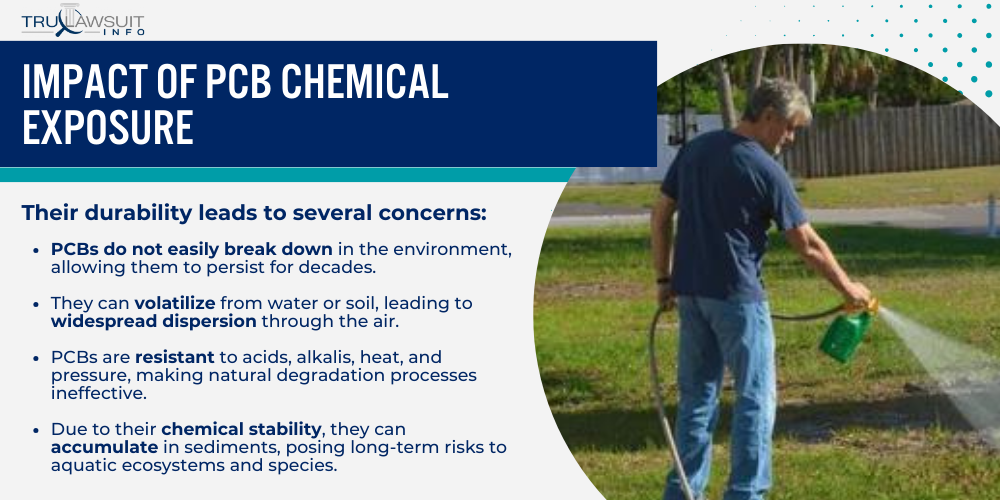
Understanding the environmental and biological challenges PCBs present is crucial for identifying exposure risks.
Environmental Persistence
Polychlorinated biphenyls (PCBs) are classified as persistent organic pollutants due to their stable chemical structure, which allows them to remain in the environment for very long periods.
Their durability leads to several concerns:
- PCBs do not easily break down in the environment, allowing them to persist for decades.
- They can volatilize from water or soil, leading to widespread dispersion through the air.
- PCBs are resistant to acids, alkalis, heat, and pressure, making natural degradation processes ineffective.
- Due to their chemical stability, they can accumulate in sediments, posing long-term risks to aquatic ecosystems and species.
Bioaccumulation and the Food Web
Within the food web, PCBs can bioaccumulate, especially in organisms’ body fat.
This bioaccumulation becomes more concentrated as it moves up the food chain, presenting significant health concerns.
Understanding the dynamics of PCB bioaccumulation reveals its pervasive impact on ecosystems and species, including humans:
- These chemicals dissolve in fats rather than water, allowing them to enter and persist within the food chain readily.
- PCBs accumulate in the fatty tissues of organisms, increasing in concentration as they move up the trophic levels.
- Top predators, including humans, are at risk due to the biomagnification of PCBs, which results in higher levels of these chemicals in their system.
- The chemical properties of PCBs facilitate their long-term retention in biological systems, leading to potential chronic health effects.
By highlighting the process of bioaccumulation and biomagnification, it becomes evident how PCBs pose a substantial threat to both wildlife and human health, underscoring the need for vigilant environmental management and pollution control measures.
Current Research on PCBs: Probable Carcinogens
Numerous studies have closely examined polychlorinated biphenyls (PCBs) to understand their effects on human health, with a growing body of research suggesting that some PCB compounds are probable carcinogens.
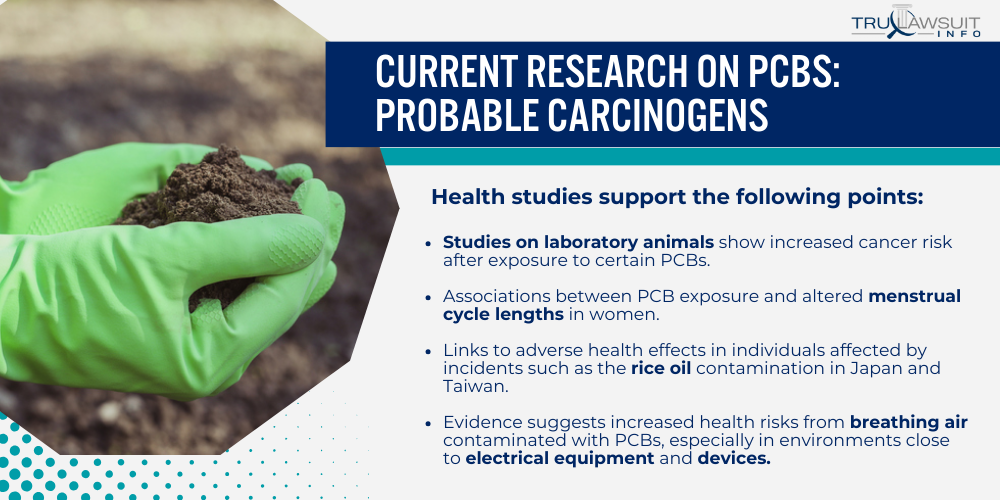
Health Studies
Research has firmly established a correlation between PCB exposure and an array of health concerns. Investigations have identified how certain PCB compounds, specifically those considered dioxin-like, may contribute to cancer development.
Health studies support the following points:
- Studies on laboratory animals show increased cancer risk after exposure to certain PCBs.
- Associations between PCB exposure and altered menstrual cycle lengths in women.
- Links to adverse health effects in individuals affected by incidents such as the rice oil contamination in Japan and Taiwan.
- Evidence suggests increased health risks from breathing air contaminated with PCBs, especially in environments close to electrical equipment and devices.
The tendency of PCBs to accumulate in human adipose tissue and stay in the environment for extended periods only compounds these concerns.
Advancements in Cleanup Technology
Eliminating PCBs from the environment to reduce exposure is a crucial task.
Significant strides have been made in the development of cleanup technologies.
Innovations in PCB cleanup include, but are not limited to:
- Techniques that deactivate PCBs in electrical transformers, removing a critical source of PCBs from the industrial landscape.
- Advanced filtration systems are designed to capture PCBs from the air, diminishing the potential for toxic responses from breathing air in contaminated areas.
- Bioremediation approaches that harness specific microbial processes capable of breaking down PCB compounds in soil and water.
- Progress in chemical methods that can dechlorinate PCBs, making them less toxic and easier to remove from the environment.
Frequently Asked Questions
-
They traditionally employ blood tests to measure PCB levels and analyze factors like fat tissue and breast milk in nursing mothers.
-
Individuals exposed to PCBs may exhibit symptoms such as skin conditions, including chloracne, or show signs of neurological deficits, particularly in children.
-
Electrical workers and those involved in manufacturing or repairing transformers are at higher risk for PCB exposure, which could lead to chronic health issues.
-
PCBs can lead to biodiversity loss, disrupt food chains, and cause bioaccumulation in wildlife, affecting species at various trophic levels.
-
Medical professionals suggest removal from the exposure source and supportive care for symptoms.
For example, they may recommend dermatological treatment for skin lesions.

Attorney Jessie Paluch, founder of TruLawsuit Info, has over 25 years of experience as a personal injury and mass tort attorney, and previously worked as an international tax attorney at Deloitte. Jessie collaborates with attorneys nationwide — enabling her to share reliable, up-to-date legal information with our readers.
Legally Reviewed
This article has been written and reviewed for legal accuracy and clarity by the team of writers and legal experts at TruLawsuit Info and is as accurate as possible. This content should not be taken as legal advice from an attorney. If you would like to learn more about our owner and experienced injury lawyer, Jessie Paluch, you can do so here.
Fact-Checked
TruLawsuit Info does everything possible to make sure the information in this article is up to date and accurate. If you need specific legal advice about your case, contact our team by using the chat on the bottom of this page. This article should not be taken as advice from an attorney.
You can learn more about the PCB Exposure Lawsuit by visiting any of our pages listed below:
Here, at Tru Lawsuit Info, we’re committed to helping victims get the justice they deserve.
To do this, we actively work to connect them with attorneys who are experts in litigating cases similar to theirs.
Table of Contents
Tru Lawsuit Info is a reliable source of information about issues that may affect your health and safety, such as faulty products, data breaches, and environmental hazards.
Our team of experienced writers collaborates with medical professionals, lawyers, and advocates to produce informative articles, guides, and other resources that raise awareness of these topics.
Our thorough research provides consumers with access to reliable information and updates on lawsuits happening around the country. We also can connect consumers with attorneys if they need assistance.
Here, at Tru Lawsuit Info, we’re committed to helping victims get the justice they deserve.
To do this, we actively work to connect them with attorneys who are experts in litigating cases similar to theirs.
